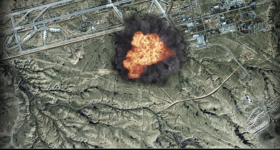By Andrew McKillop
21st Century Wire
August 22, 2011
A world financial collapse? So what exactly are we looking at here? The most recent ‘epic sized big bourse crash’, comparable to 1929, was on Oct. 19, 1987, also known as the “Black Monday” crash which witnessed a 20-percent-plus collapse of index numbers, and therefore nominal stock market value in one day on some major markets, like the USA’s Dow Jones Industrial Average or DJIA.
Since early August 2011 we have had global stock exchange falls of around 15 percent in 15 days.
Giving us a handle on what this means the 1987 crash, which saw the DJIA crash to about 1850 points wiped off an estimated $1600 billion or $1.6 trillion of nominal value, that is market capitalization, in dollars of 1987 value. As of August 22, 2011 the DJIA is at about 10 850 ponits, after major losses.
For the same amount of loss today, using official data on inflation since 1987, we would ‘need’ a loss of about $4.5 trillion.
THE STOCK MARKET CASINO
Interestingly, this has already happened, even with a loss of only 15 percent since the start of August 2011. Estimates for loss of nominal value (market capitalization) since the start of August through August 19, are well above $ 7 trillion. From the most recent high point for world exchanges, in February 2011, total losses are about $ 9 trillion.
To be sure, there is a play on words as to the meaning of a stock market “correction” versus a stock market “crash”, but we can easily forecast that losses, through September-October 2011 can reach as much as $ 24 trillion, or around 75 percent of nominal value for the world’s 16-largest stock exchanges. This will be the biggest-ever loss, in nominal value. This is based on present day turnover value, in nominal terms, on the world’s 16-largest exchanges, estimated at around $ 36 trillion-a-year in 2010. http://www.loansandcredit.com/worlds-largest-stock-exchanges/
WHY IT HAPPENED
Retrospective myth-making on the 1987 crash noted that Iran had fired missiles over the Persian Gulf, causing some nervous moments, rather like Hamas firing missiles on Israel, today. The decisive factor, for some myth-makers treating the 1987 event, was that 24 years ago the US wanted a lower-valued dollar, rather like Obama wants today, prompting foreign investors to start dumping stocks, fearing exchange rate-related losses. The curious thing, here, is that the Plaza Accord cut in 1985 of the US dollar’s value against the yen by about 40 percent, and by around 20 percent against the German Deutschmarks had almost no impact at all on “investor sentiment” ! Can we imagine it took those hands-on traders about 2 years to wake up to the news ?
As we see already, “investor sentiment” is a special herd thing, possibly quite mysterious. It in fact relates to the basic reality of the value-creation process – firstly creating ex nihilio, then trading “negotiable securities”, AKA tradable assets, in the most perfectly unregulated and corrupt way possible. When their value collapses, as it can only, and will only, these paper chits and fragile promises are binned – in a slash and burn process we can call “Delete, Deplete, and Move On”.
Another favoured explanation of why investor sentiment was so bad in October 1987 is that markets were not well protected by Plunge Protection, at the time. Programme selling software did not face the circuit-breakers which today stop trading after there is about a 10 percent decline in any one trading day. In other words and in theory, we could have a 50 percent fall in one 5-day trading week but we can’t have 20-percent-off in a single day.
In March 2011, following the Fukushima nuclear disaster, Japan’s Topix index tanked by 12 percent in a single day (15 March), the biggest single day loss since the 1987 crash, in a panic sell off similar to what all stock exchanges are capable of, when sentiment is right. The 15 March 2011 crash, in Japan, caused a loss of around $400 billion of nominal value in 1 day.
NOT JUST THE CLOSING BELL
In the good old days of 1987, falling markets resulted in yet more selling, which basically snowballed as computer-generated trades kept pressure on the markets all day and all week.
As observers remarked: “The only thing that kept markets from melting down even more, each day, was the closing bell” – but the bell rang on a very different world relative to 2011.
Money growth is one feeder of market growth. This is the basic fuel for the delirious and unreal illusions created, vectored and sold, to the unwary, by stock market operators since they started operating in their ‘modern’ format, in the first two decades of the 18th century. Interestingly, these very first modern-type stock market “shell games” were all related to, or triggered by attempts to cut the crippling debts of royal families and their noble allied leading families.
Basically, we have a situation where the state can print money, and its close supporters in the financial world can print share certificates. This notional value – and the word “notional” has meanings close to the word “fictional” – can then be swapped against real assets, starting with gold and silver bars and coins, and extending to oil, food, minerals, land and any other real asset. At the largest most aggregate level it is obvious the amount of nominal “value” a market can first create, and then lose will depend on how much fiat monetary value existed and circulated, before the crash.
The two forms of unreality are linked. Both are a socialized and cultural bet on what the words “value” and “confidence” mean. The average taxpayer and consumer is the sucker or patsy – of course.
Depending how we interpret the data, for example world M1/M2/M3 money creation since 1987, world stock market capitalization and turnover, and global economic growth since 1987, we can suggest that world stock exchanges, today, could be overvalued by as much as 100-to-1 in real terms. The “correction” that is both possible – and needed – would be a 99 percent fall of average stock exchange values from early August 2011 levels, or about another 75 percent from August 22 levels.
GLOBAL COLLATERAL DAMAGE
Taking as one example, fast growing emerging economy giant India shows what kind of expansion of money supply is possible in a short period of time:
http://www.thehindubusinessline.com/features/investment-world/article2037972.ece
On top of the money supply growth, multiplying the potential damage from stock market crashes, we can note in the Indian case – and worldwide – at least three other key factors.
The first is that “cash equities”, where stocks, bonds or other traded assets are bought using cash are seriously going out of style: in India today, as elsewhere, around 90 percent of tradable assets ares NOT bought for cash or using cash. They are acquired or created through derivatives trading. Next, the revolutionary expectations – always growing – of market operators and traders are surely and certainly raised by so-called ‘financial engineering’ which has telescoped previously separate asset spaces, for example government debt (bonds) and company stocks (equities) and raw materials (commodities) in a so-called “seamless asset space”. In turn and next, we have the interconnection of exchanges worldwide, further raising the potential for “value growth”. In nominal value terms (although nominal value has no real meaning, because all engineered assets have counterpart liabilities – sometimes huge) world stock market turnover volume has grown at least 20-fold since 1987.
Stock market crashes can and should reflect this reality. Losses since February 2011, and particularly since the start of August can very simply be the start of a historic process of adjusting the unreal and fantasist “tradable asset economy” to the realities of what is called the “real economy”.
LOST AND FOUND VALUE
Today’s crash could, or should therefore be 15 times bigger than the 1987 crash, causing 24 trillion lost but nominal dollars, if we want to stay in the running for Guinness book of records status. In rough terms this would represent a coming and further 75 percent loss of nominal capitalization for the world’s 16-biggest exchanges, but how would we engineer these losses ?
This will be difficult, even with Hamas rockets raining into Israel and Mr Obama talking down (without even moving his lips) the dollar each day, despite the huge competition the US dollar has – for lost value – facing the overvalued, shaky and worthless rivals called the euro and yen.
The crash sequence is when everybody tries to sell everything, with or without the help of “asset management software”. The effect should first be inflationary – a certain amount of cash leaks out of the paper circus – and should then be deflationary, due to enterprises being starved of credit, loans, or investment capital. The most exposed companies are however instantly identifiable: banks, insurers, brokers and related entities.
Unfortunately, in our present day real-unreal world, the newly bankrupt banks and insurance companies, already bailed out in 2008-2009, will predictably tank again, and get bailed out again. Government debt will become yet more lurid.
We cannot predict what will happen after that – because we never previously had simultaneous and total national bankruptcy of nearly all the world’s previously richest countries.
However, there is a simple, if courageous solution for out cowardly political leaders. They have to Delete-Deplete-Move On. During the crash, asset values will be compressed by huge amounts: governments can buy and nationalize the companies they already bailed out, using public money in 2008-2009. We cannot even be sure that governments will manage these assets even worse than the sacrosanct “private players” because private capital has so entirely destroyed the economy since the period of 2005-2007. Can the state do even worse ? Tune in later…
The ‘flat-line’ solution is therefore possible. Markets bottom out, and stay there. The state moves in, to freeze the dynamic, firstly calling a 6-month truce, during which the economy starts being restructured, from top to bottom.
To be sure, political and legislative action (and cultural revolution) is needed to ensure that, so we must accept we are in a totally new dimension. Welcome to the future !
READ MORE FROM THIS AUTHOR HERE
*****

















